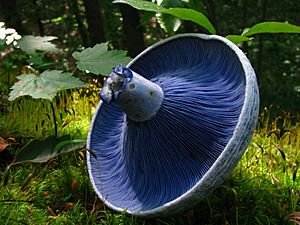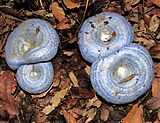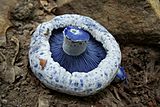Indigo milk cap facts for kids
Quick facts for kids Indigo milk cap |
|
|---|---|
 |
|
| The gills of L. indigo | |
| Scientific classification | |
| Genus: |
Lactarius
|
| Species: |
indigo
|
| Synonyms | |
|
Agaricus indigo Schwein. (1822) |
|
| Lactarius indigo | |
|---|---|
| Mycological characteristics | |
| gills on hymenium | |
| cap is depressed | |
| hymenium is adnate or decurrent | |
| stipe is bare | |
| spore print is yellow | |
| ecology is mycorrhizal | |
| edibility: edible | |
The Lactarius indigo, also known as the indigo milk cap or blue milk mushroom, is a special type of mushroom. It belongs to the Russulaceae family. This mushroom grows naturally in many places, including eastern North America, East Asia, and Central America. It has also been found in southern France.
L. indigo grows on the ground in both deciduous (trees that lose leaves) and coniferous (cone-bearing trees) forests. It forms a special connection with tree roots, which helps both the mushroom and the tree. When the mushroom is fresh, its color is dark blue. As it gets older, it turns a pale blue-gray. If you cut or break the mushroom, a blue liquid, called latex, oozes out. This blue liquid slowly turns green when it touches the air. The cap of the mushroom is usually 5 to 15 centimeters (2 to 6 inches) wide. The stem is 2 to 8 centimeters (1 to 3 inches) tall and 1 to 2.5 centimeters (0.4 to 1 inch) thick. This mushroom is safe to eat. It is sold in markets in China, Guatemala, and Mexico. In Honduras, people call it "chora" and often eat it with eggs.
Contents
About the Indigo Milk Cap
The indigo milk cap was first described in 1822 by an American mushroom expert, Lewis David de Schweinitz. He called it Agaricus indigo. Later, in 1838, a Swedish expert named Elias Magnus Fries moved it to the Lactarius group. The name indigo comes from a Latin word meaning "indigo blue," which perfectly describes its color. People also call it the "indigo milk cap," "indigo Lactarius," or "blue milk mushroom." In central Mexico, it has local names like añil and hongo azul.
What the Indigo Milk Cap Looks Like
Like many mushrooms, the indigo milk cap starts as tiny threads underground called mycelium. These threads are made of fungal cells called hyphae. When the weather is right, these threads grow into the visible mushroom, which is the fruit body.
The mushroom's cap is usually 5 to 15 centimeters (2 to 6 inches) wide. When it's young, the cap is rounded, but it later gets a dip in the middle. As it ages, the dip becomes deeper, making the cap look like a funnel. The edge of the cap is rolled inward when the mushroom is young.
When fresh, the cap is indigo blue. But it fades to a lighter grayish or silvery-blue, sometimes with green spots. It often has rings of alternating light and dark blue, especially near the edge. Young caps feel sticky.
The inside of the mushroom, called the flesh, is pale or bluish. It slowly turns greenish when exposed to air. Its taste is mild or slightly peppery. The whole mushroom is brittle, meaning it can snap easily. The blue liquid, or latex, that comes out when the mushroom is cut also stains the injured part green. This liquid tastes mild. Older indigo milk caps might not produce much latex because they dry out.
The gills are the thin plates under the cap. They are indigo blue and become paler with age or turn green if damaged. They are attached to the stem or run slightly down it. The stem is 2 to 6 centimeters (1 to 2 inches) tall and 1 to 2.5 centimeters (0.4 to 1 inch) thick. It is also indigo blue or silvery-blue. The stem is solid when young but becomes hollow as it ages. Like the cap, it's sticky when young but dries out. The stem is usually in the middle of the cap, but sometimes it can be off-center. These mushrooms do not have a strong smell.
There is a smaller version of this mushroom called L. indigo var. diminutivus. Its cap is 3 to 7 centimeters (1 to 3 inches) wide, and its stem is 1.5 to 4.0 centimeters (0.6 to 1.6 inches) long and 0.3 to 1.0 centimeters (0.1 to 0.4 inches) thick. It is often found in Virginia.
Microscopic Features
When you look at the mushroom's spore print, the spores appear cream to yellow. Under a light microscope, the spores are clear and shaped like an oval or almost a circle. They have tiny bumps and measure about 7–9 by 5.5–7.5 micrometers. The cells that produce spores are called basidia. They are about 37–45 micrometers long.
Similar Mushrooms
The indigo milk cap is easy to spot because of its unique blue color and blue latex. Other Lactarius mushrooms might have some blue, but they are different. For example, the "silver-blue milky" (L. paradoxus) has a grayish-blue cap when young, but its latex and gills are reddish-brown or purple-brown. L. chelidonium has a yellowish or dull yellow-brown cap and yellowish or brown latex. L. quieticolor has blue flesh in its cap but orange or red-orange flesh in the base of its stem.
Is it Edible?
Yes, L. indigo is an edible mushroom. However, people have different opinions on how tasty it is. Some experts think it's "superior," while others say it's only "mediocre." It might have a slightly bitter or peppery taste and a coarse, grainy texture. It's best to slice the firm flesh thinly when cooking. The blue color disappears when cooked, and the mushroom turns grayish. It's not good for drying because of its texture. If a mushroom produces a lot of blue liquid, it can be used to add color to marinades.
In Mexico, people gather these wild mushrooms to sell at markets from June to November. They are considered a "second class" mushroom for eating. L. indigo is also sold in Guatemalan markets from May to October. It is one of 13 Lactarius species sold in markets in Yunnan, China.
What Makes it Blue?

Scientists have studied the indigo milk cap. It contains a lot of water, protein, and dietary fiber. It also has healthy fats. The blue color of L. indigo comes from a special natural chemical called (7-isopropenyl-4-methylazulen-1-yl)methyl stearate. This chemical is a type of azulene, which is a blue pigment. It's unique to this mushroom.
Where the Indigo Milk Cap Lives
Lactarius indigo is found across southern and eastern North America. It is most common along the Gulf Coast, in Mexico, and in Guatemala. It is sometimes found in the Appalachian Mountains in the United States. It has also been collected in China, India, Guatemala, and Costa Rica. In Europe, it has only been found in southern France so far. In Mexico, the mushrooms grow most during the rainy season, from June to September.

L. indigo is a mycorrhizal fungus. This means it has a special partnership with the roots of certain trees. The fungus helps the tree by getting minerals and amino acids from the soil. In return, the tree gives the fungus sugars it makes through photosynthesis. The fungus's underground threads grow around the tree's tiny roots. This helps the tree get nutrients more easily.
Because of this partnership, you usually find L. indigo growing on the ground in both deciduous and coniferous forests. They are also often found in areas that have recently been flooded. In Mexico, they grow with trees like Mexican alder and American Hornbeam. In Guatemala, they grow with Mexican pine and other pine and oak trees. In Costa Rica, they partner with several native oak trees.
See also
 In Spanish: Lactarius indigo para niños
In Spanish: Lactarius indigo para niños
- List of Lactarius species




